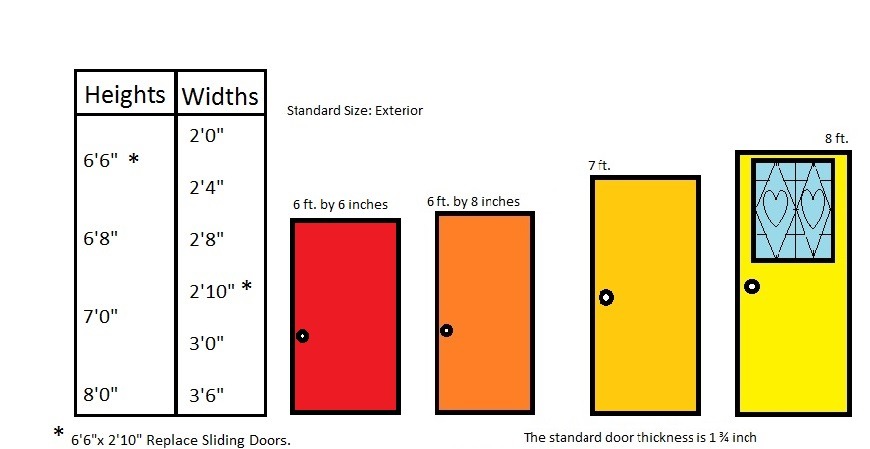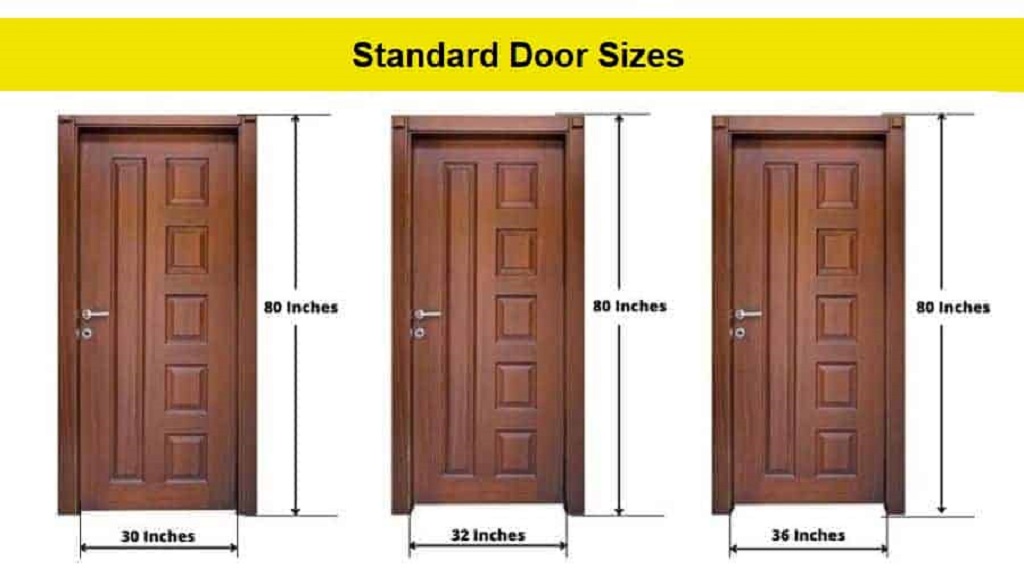Navigating a doorway with a large piece of furniture or appliance can be daunting, and many have found themselves contemplating the standard height of door frames during such endeavors. I, too, have experienced the occasional head bump while maneuvering bulky items inside my home. Adding to the complexity, there’s the potential hurdle of a vertical crack above the door frame. So, beyond just considering the height, you must also be mindful of unexpected obstacles like cracks that might complicate the process.
As it turns out, a standard door frame height has been used for decades. In this article, we’ll break down the typical height of interior and exterior door frames, discuss what building standards determine these measurements, and review some tips for measuring your door frames. At the end, I’ll also answer some frequently asked questions about door frame sizes.
The Standard Interior Door Frame Height

Most interior door frames in the United States are 80 inches tall. That’s 6 feet and 8 inches, for those of us who still think in feet and inches.
This 80-inch measurement is the standard specification for interior door frames under the International Residential Code (IRC), which sets the building standards for one- and two-family homes across much of the U.S. and Canada. The IRC determines the minimum room and door sizes for safe and convenient access within a home.
So, if your home was built anytime in the last few decades according to IRC guidelines, chances are your interior doors are all 80 inches high from the floor to the header. Some older homes may have slightly shorter internal door frames, but 80 inches remains the modern standard.
Typical Exterior Door Frame Heights
Exterior door frames are often slightly taller than interior frames. The most common exterior door frame height is 82 or 84 inches.
This extra height on outside doors allows thicker walls to insulate better and soundproof the home. Since exterior walls contain insulation and possibly brick, stucco, siding materials, etc., they’re usually more expansive than interior walls. That extra wall thickness adds a few inches to the total exterior door frame height.
Like interior doors, most exterior door frame sizes follow the standard building specifications of the IRC sets. Other building standards, like the International Building Code (IBC), also dictate the approved sizes for exterior door frames on commercial structures.
Where Do These Standard Measurements Come From?

You might be wondering why 80 inches became the go-to for interior door frame height in the first place. And who determines what the standards should be?
It mainly comes down to ergonomics. The standard door height of 80 inches leaves a few inches of clearance above most people’s heads as they walk through. This clearance helps accommodate hairstyles and hats and allows comfortable passage without bumping into the top of the frame.
Of course, not everyone is the same height. So, the standard door frame height aims to provide head clearance for most of the population. The average human height is different for males and females, varying worldwide. Building standards like the IRC consider typical human heights when setting their specifications.
Beyond human ergonomics, standard door sizes must also accommodate furniture and appliance dimensions. Clear passage for safely moving large items in and out of rooms is a practical consideration for home building standards.
Tips for Measuring Your Door Frames
If you need to measure the frame height around a door in your home, here are some tips:
- Use a steel tape measure. Cloth tape measures can stretch and bend over time, yielding inaccurate measurements. A steel tape measure will give you the most precise reading.
- Measure from the floor to the header. The header is the horizontal structural beam that forms the top of the frame. Don’t include any molding or trim that extends beyond the header.
- Take measurements at both sides and the middle. Door frames are sometimes uneven, so measure at three points for accuracy. Use the shortest measurement.
- For exterior doors, measure from indoors if possible. Outdoor measurements can be thrown off by bulging stucco, uneven brickwork, or settling issues. Measure against the inside wall for the actual frame height.
- Photo document the process. Take photos looking straight on at the tape measure in the door frame. This gives you a helpful reference record of the exact measurements.
Double-check a few times for the most precise measurement. An extra minute spent confirming your numbers can prevent significant headaches.
What If My Door Frames Are Shorter Than the Standard Size?
If you discover your interior door frames are shorter than 80 inches, don’t panic! Some homes have slightly shorter interior doors for a variety of reasons:
- Older construction – Homes built before 1970 often had 76-inch interior door frames. Updated building standards over time led to taller standard heights.
- Low ceiling heights – Overall room heights may dictate shorter door frames in basements or attics with slanted ceilings.
- Regional variances – Certain areas developed local trends that didn’t always follow national model building codes. You may find pockets of homes with shorter frames.
- Renovation remnants – If walls and door frames were moved during renovations, previous dimensions may remain throughout the home.
While less common today, these shorter interior door frame heights are usually fine structurally. But if your doorway clearance feels uncomfortably tight, you can look into expanding the frame height during renovations. Raising a door by a few inches to gain overhead space can make a noticeable difference.
Minor variations from the standard are typically not problematic for exterior doors as long as the frame height falls between 80 and 84 inches. But if an outer door frame turns out to be significantly shorter than expected based on the wall thickness, inspect closely for any underlying issues. Significant frame height discrepancies could signify settling, sagging, or other structural concerns.
FAQs
What is the standard width for interior door frames?
Most interior door frames within the rough opening are 32 or 36 inches wide. This leaves room for standard internal door sizes of 24, 28, and 30 inches.
What about sliding glass patio doors?
Sliding patio doors often have a frame height of 80 inches, matching standard interior doors. However, widths vary based on design and manufacturer. Standard sliding patio door widths range from 59 to 104 inches wide.
How tall are garage door frames and commercial entry doors?
Garage door heights can be anywhere from 6 to 10 feet tall. Commercial entry and glass door frame heights often start around 80 inches but may reach 9 or 10 feet for taller lobbies and entrances.
Do ADA requirements mandate different door frame sizes?
For commercial buildings, the ADA standards specify minimum precise doorway openings of 32 inches wide and 80 inches high for accessible doorways. The ADA does not set more extensive frame size requirements but does regulate usable clearance.
What is the standard height for bifold and accordion doors?
Bifold and accordion door frame heights usually match standard interior door frames. Accordion doors need vertical clearance for their stacked folding operation, but typical heights remain 80 inches.
In Summary
No matter how carefully you measure each opening, you’re bound to forget the standard interior door frame height at some point and bonk your head! But now that you know that 80 inches is the magic number, hopefully, you can save yourself some bumps and bruises.
An extra couple of inches are added for thicker walls for exterior doors. Minor height variations in both interior and exterior doors are not necessarily problematic. Expanding the frame height during renovations is an option if clearance feels uncomfortably tight.
Enhance your doors with exquisitely crafted inserts and discover the impact of knowing standard door frame sizes—a knowledge that proves invaluable when navigating bulky furniture or appliances through your home, where those extra inches of clearance truly make a difference.




